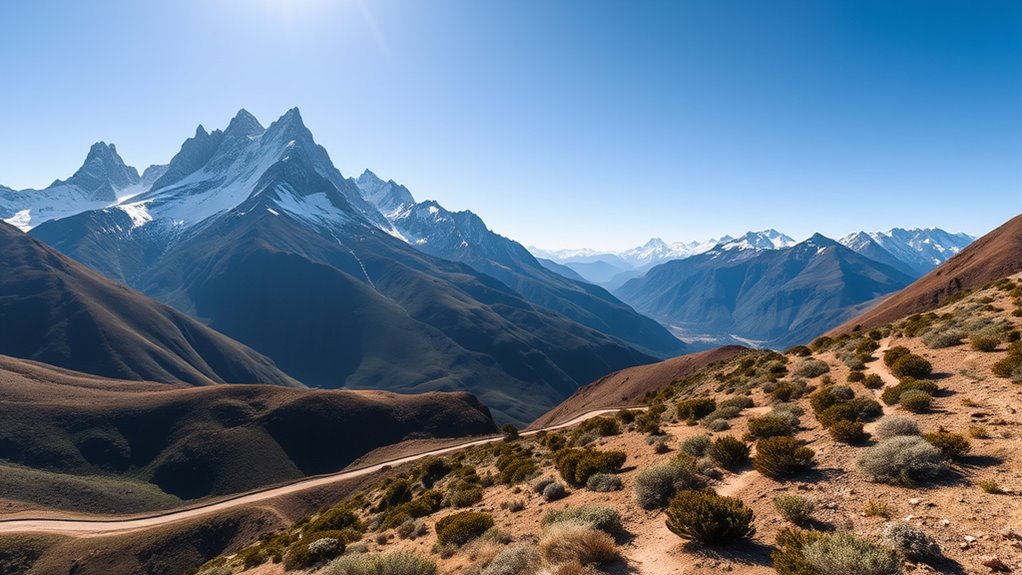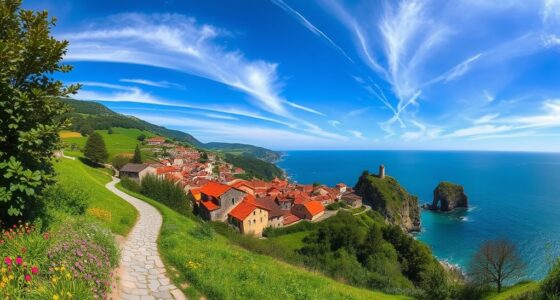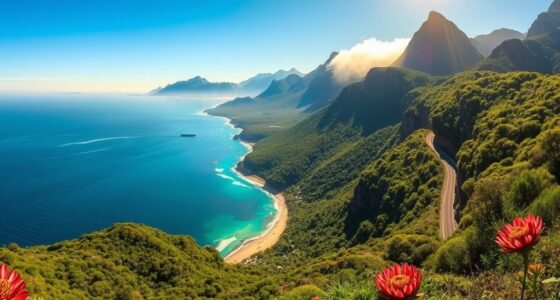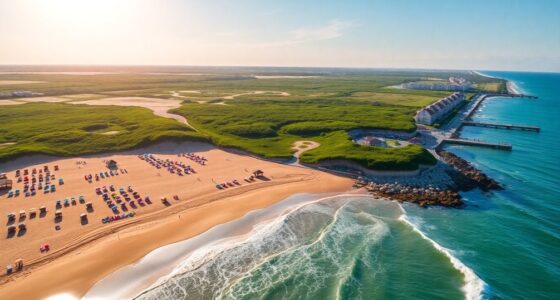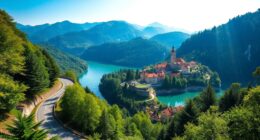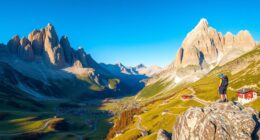Begin a 15-day journey exploring Peru and Chile’s rich heritage, from the ancient marvels of Machu Picchu and Cusco’s sacred sites to the stunning landscapes of the Sacred Valley. Cross the Andes into Chile’s arid Atacama Desert, home to surreal salt flats and geothermal wonders like the El Tatio Geysers. Experience vibrant local traditions, cuisine, and cultural festivals. Discover the deep connections between these regions—continue onward to uncover more incredible sights and stories.
Key Takeaways
- The segment covers iconic Inca sites like Machu Picchu, Cusco, and Sacred Valley in Peru.
- It includes exploration of Chile’s Atacama Desert and geothermal features such as El Tatio Geysers.
- Travelers experience diverse landscapes from Andean mountains to arid desert environments.
- Cultural immersion involves local markets, traditional textiles, music, and regional cuisine.
- The itinerary combines archaeological wonders, natural scenery, and cultural heritage across Peru and Chile.
Discovering the Mysteries of Machu Picchu
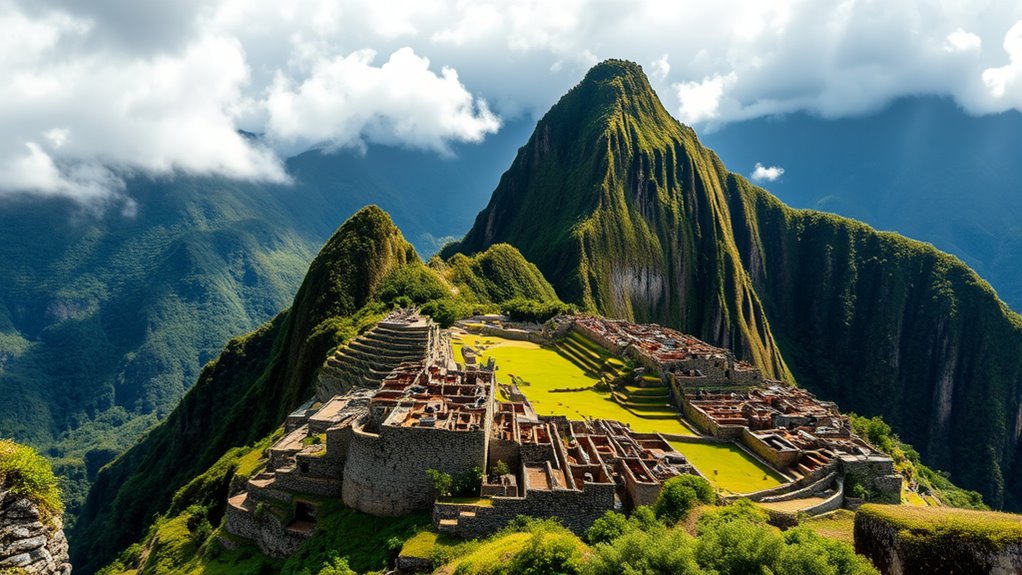
Machu Picchu remains one of the most mesmerizing archaeological sites in the world, drawing countless visitors enthusiastic to uncover its secrets. As you explore, you’ll notice the brilliance of Inca architecture—stone terraces, precisely cut stones fitting together without mortar, and sophisticated water management systems. The site’s construction reflects advanced engineering and harmony with the surrounding landscape. Beyond the stones, you get a glimpse of Inca artistry through vibrant Andean textiles, which reveal intricate patterns and cultural symbolism. These textiles, often displayed in local markets, help you understand the Inca’s rich tradition of weaving and storytelling. Additionally, the advanced water management systems demonstrate the Inca’s engineering prowess in maintaining sustainable infrastructure. By observing both the architecture and textiles, you gain a deeper appreciation for the ingenuity and cultural depth of the civilization that once thrived here.
Exploring Cusco’s Cultural Heritage
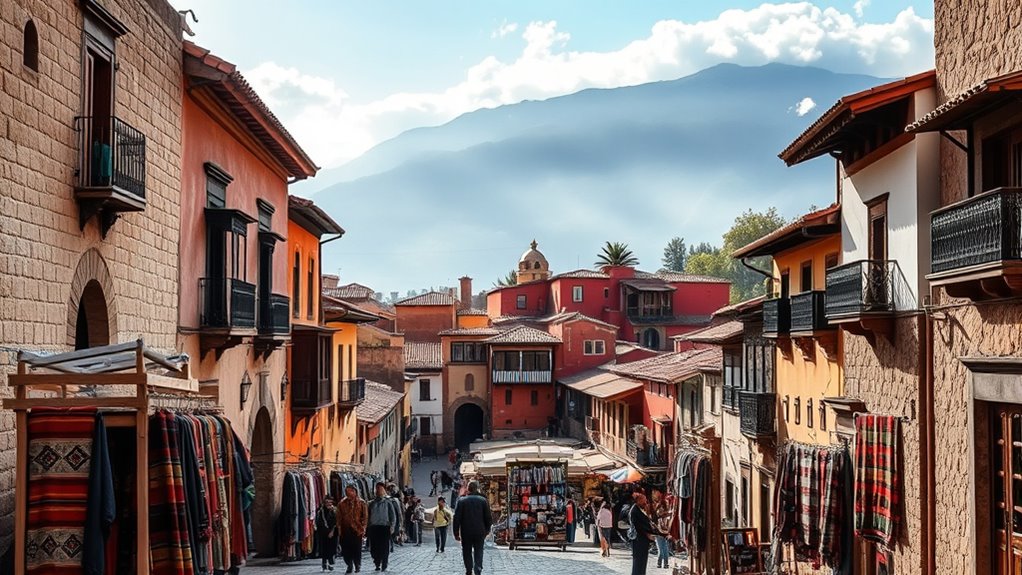
As you explore Cusco’s rich cultural heritage, you’ll encounter ancient Incan sites that tell stories of a powerful civilization. Sacred religious spots invite you to experience spiritual traditions still alive today. Don’t miss the chance to witness vibrant cultural events that showcase Cusco’s enduring traditions. Incorporating cultural preservation efforts, the city maintains its historical authenticity while welcoming visitors from around the world. Additionally, ongoing technology integration helps preserve these sites through innovative solutions. Modern self watering plant pots also exemplify how traditional methods can be complemented by modern innovations to protect and sustain cultural and natural heritage. Practicing mindful decluttering can assist communities in emphasizing their cultural artifacts and shared history, ensuring that heritage conservation efforts are sustainable and respectful of local values.
Ancient Incan Sites
Cusco, once the heart of the mighty Inca Empire, offers a fascinating glimpse into ancient civilization through its well-preserved archaeological sites. As you explore, you’ll notice stunning Incan architecture, characterized by precisely cut stones fitting together without mortar. These structures reveal advanced engineering and a deep understanding of seismic activity. Many sites once hosted ancient rituals, blending spiritual practices with everyday life. Walking through these ruins, you can imagine the ceremonies that once took place here, connecting you to the spiritual world of the Incas. Each stone and pathway tells a story of a civilization that valued harmony with nature and complex societal rituals. Visiting these sites allows you to step back in time and appreciate the ingenuity of the Incan culture. The skillful construction techniques used here demonstrate the Incas’ remarkable architectural mastery, which has allowed many structures to withstand centuries of earthquakes and natural wear. This engineering ingenuity highlights their sophisticated knowledge of seismic-resistant construction techniques. Additionally, understanding their seismic resistance techniques offers insights into their ability to adapt to their environment and protect their cultural heritage. Furthermore, their use of natural materials and adaptive building methods reflects a profound environmental awareness that contributed to their enduring structures.
Sacred Religious Spots
Nestled within Cusco’s vibrant streets are sacred religious spots that highlight the city’s spiritual heritage. You can visit impressive Incan temples like Qorikancha, once the heart of Incan worship and now a striking blend of Inca and colonial architecture. These sacred sites once hosted sacred rituals, offering insight into their spiritual practices. As you explore, you’ll notice the precise stonework and symbolic carvings that reveal the deep religious significance of these locations. Walking through these spaces, you sense the enduring reverence for the divine that shaped Cusco’s history. The spiritual atmosphere invites reflection on the ancient rituals performed here, connecting you to the city’s rich Incan traditions that continue to influence its cultural identity today. Preservation efforts ensure that these sites remain a testament to Cusco’s enduring cultural and religious legacy. Additionally, understanding the religious symbolism embedded in the architecture enhances appreciation of the spiritual importance of these sites. Recognizing the historical significance of these locations helps deepen your appreciation for their cultural and spiritual roles throughout history. Furthermore, ongoing restoration projects help maintain the authenticity and integrity of these sacred spaces for future generations. Engaging with traditional spiritual practices still observed at some sites underscores the living connection between past and present.
Traditional Cultural Events
Have you ever wondered how Cusco’s lively festivals and traditional events preserve its rich cultural identity? When you attend these celebrations, you experience vibrant local dance performances that showcase centuries-old customs. Traditional festivals like Inti Raymi and Corpus Christi draw locals and visitors alike, offering a glimpse into Cusco’s heritage. During these events, the streets come alive with colorful costumes, rhythmic music, and spirited dance routines rooted in indigenous traditions. Participating in or observing these festivals helps you appreciate how Cusco keeps its history alive through community involvement and cultural pride. These events serve as a mesmerizing reminder of the city’s deep roots and its ongoing commitment to preserving its unique cultural legacy for generations to come. Moreover, these celebrations foster intercultural understanding among diverse groups, enriching the communal experience. Understanding the regulatory frameworks that support these cultural expressions highlights their importance in maintaining traditions. Additionally, the preservation of traditional practices is often strengthened through local policies and community-led initiatives, ensuring these customs endure amidst modern influences. Recognizing the role of cultural heritage preservation further emphasizes how these events sustain Cusco’s vibrant identity.
Journey Through the Sacred Valley
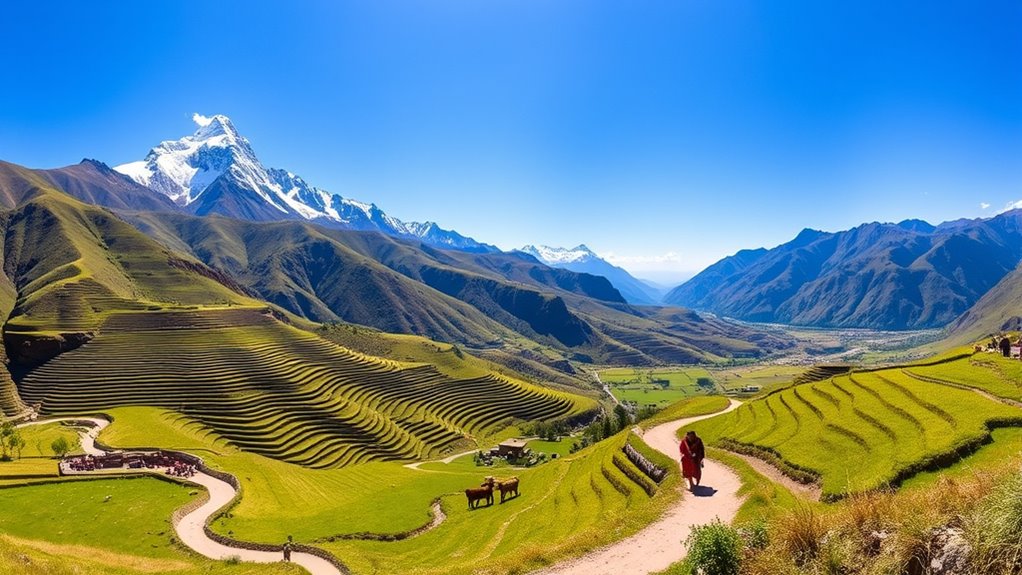
As you explore the Sacred Valley, you’ll encounter remarkable Incan sites that showcase ancient engineering and spirituality. Interacting with local communities offers authentic cultural experiences that deepen your understanding of the region’s history. This journey connects you directly to the legacy of the Incas and their enduring traditions. Paying attention to ancient artifacts can provide further insights into their innovative techniques and cultural significance. Exploring archaeological discoveries can also reveal more about the technological prowess of the Incas and their mastery of construction. Studying archaeological methods used in excavations enhances appreciation for the meticulous processes involved in uncovering these historical treasures and the interpretation of symbols that can emerge from these findings.
Ancient Incan Sites
The Sacred Valley is a treasure trove of ancient Incan sites that reveal the grandeur of their civilization. As you explore, you’ll encounter remarkable examples of Incan architecture, built with precisely cut stones that fit together without mortar, showcasing their engineering mastery. These sites served as hubs for sacred rituals, where Incas performed ceremonies to honor their gods and ensure agricultural fertility. Machu Picchu, perched high above the valley, is the most iconic, blending spiritual significance with stunning craftsmanship. Nearby, Ollantaytambo features terraces and temples that highlight strategic design and religious importance. Walking through these sites, you’ll sense the deep spiritual connection the Incas had with nature and their sacred practices, offering a profound glimpse into their cultural and spiritual world.
Local Cultural Experiences
Stepping beyond the ancient sites, the Sacred Valley offers vibrant opportunities to experience local culture firsthand. You can visit small workshops where artisans craft colorful textiles, pottery, and jewelry, giving you a chance to see traditional techniques passed down through generations. As you explore local markets, you’ll encounter artisans selling their unique creations, connecting you directly with the community’s heritage. Don’t miss the chance to immerse yourself in indigenous music performances, where lively rhythms and soulful melodies showcase the region’s rich cultural roots. Engaging with local artisans and musicians provides a deeper appreciation of the Sacred Valley’s vibrant traditions, making your journey more meaningful and authentic. These experiences bring you closer to the heart of Andean culture beyond the ruins.
Crossing the Andes Into Chile’S Atacama Desert
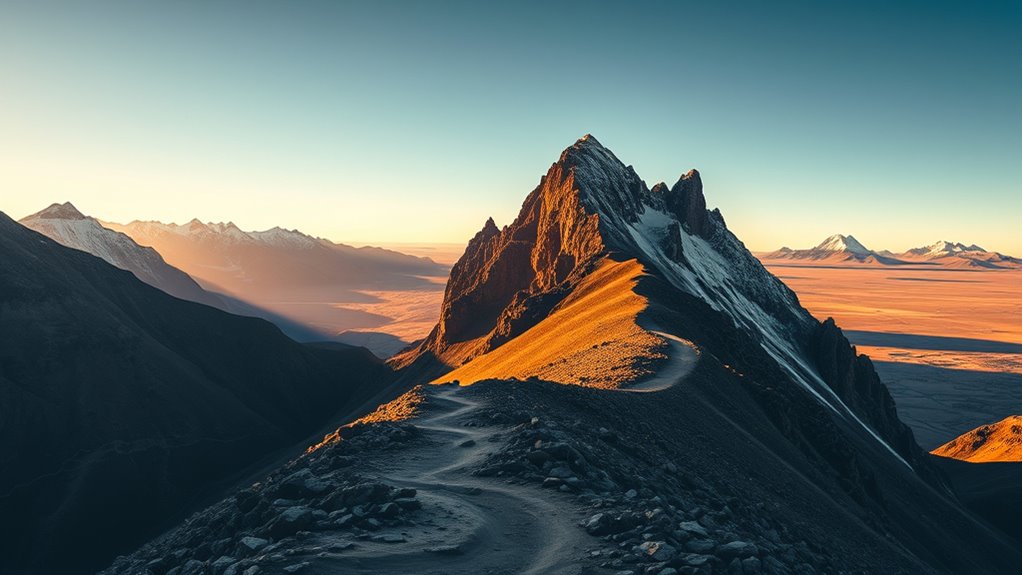
Crossing the Andes into Chile’s Atacama Desert presents a dramatic shift from lush mountain scenery to one of the world’s most arid landscapes. During your Andes crossing, you’ll notice the changing vistas as snow-capped peaks give way to stark desert landscapes. Here’s what awaits you:
- Breathtaking views of rugged mountain passes
- Sudden shift to expansive, dry valleys
- Unique geological formations shaped by erosion
- The silence of the vast, arid desert environment
This journey transforms your perspective, highlighting nature’s extremes. The high-altitude crossing offers striking contrasts, revealing the raw power of the landscape. Once you descend, the dry, breathtaking scenery of the Atacama unfolds, immersing you in one of the most extreme desert landscapes on Earth.
Experiencing the Unique Landscapes of San Pedro De Atacama
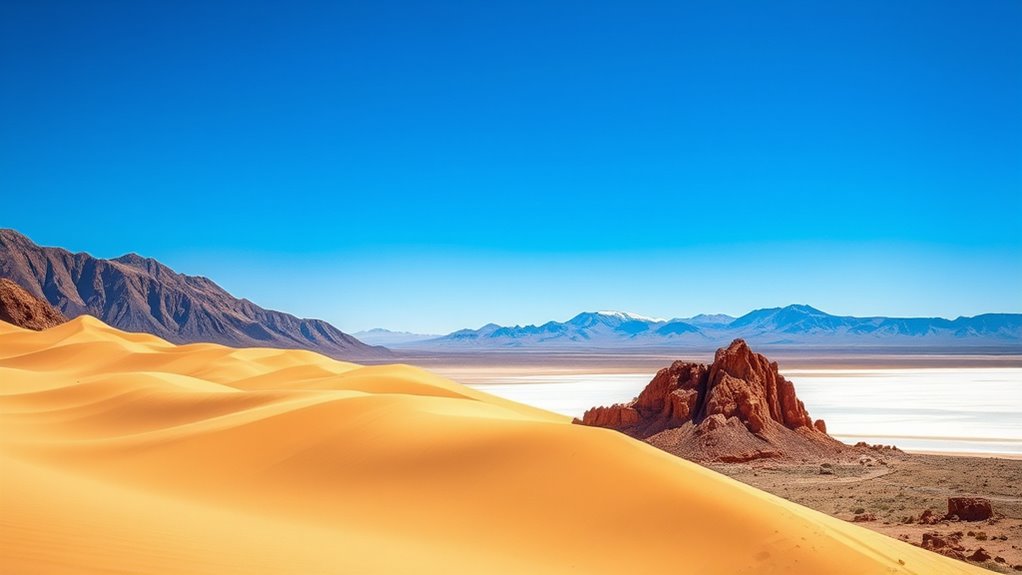
As you arrive in San Pedro de Atacama, you’ll immediately notice a surreal landscape that seems almost otherworldly. Towering salt flats shimmer under the sun, and ochre-colored hills stretch to the horizon. You’ll find yourself immersed in a desert filled with unique desert flora, such as cacti and hardy bushes that thrive despite the harsh environment. Keep an eye out for Andean wildlife, including llamas, foxes, and various bird species that have adapted to this extreme landscape. The air feels crisp and dry, emphasizing the stark beauty of the region. Every turn reveals a new, mesmerizing vista—an extraordinary landscape that’s both desolate and enthralling, offering an unforgettable experience of one of the world’s most extraordinary deserts.
Visiting the Geothermal Wonders of El Tatio Geysers
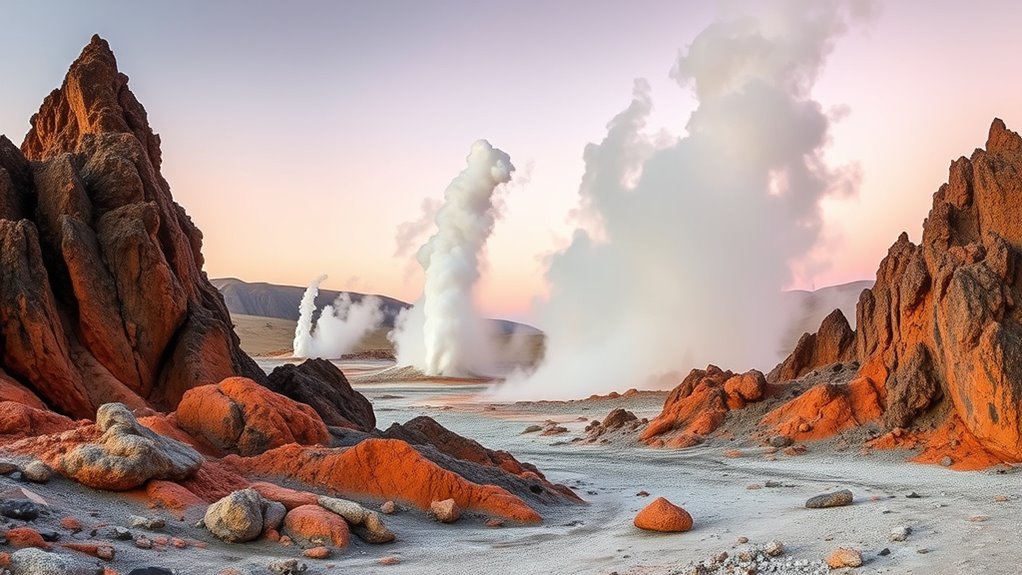
The El Tatio Geysers offer one of the most spectacular geothermal displays in the world, drawing visitors to witness an otherworldly eruption of steam and boiling water. This site showcases intense geothermal activity within a rugged volcanic landscape. When visiting, you’ll want to:
- Wake early to see the geysers at sunrise, when steam vents burst vigorously.
- Walk around the bubbling hot springs and fumaroles, feeling the heat beneath your feet.
- Capture stunning photos of steam plumes against the high-altitude sky.
- Learn about the geothermal processes that power this natural wonder, shaped by volcanic activity.
You’ll experience the power of volcanic landscapes up close while marveling at the vibrant activity beneath the Earth’s surface, making El Tatio a must-see destination for geothermal enthusiasts.
Embracing the Local Traditions and Cuisine of Northern Chile
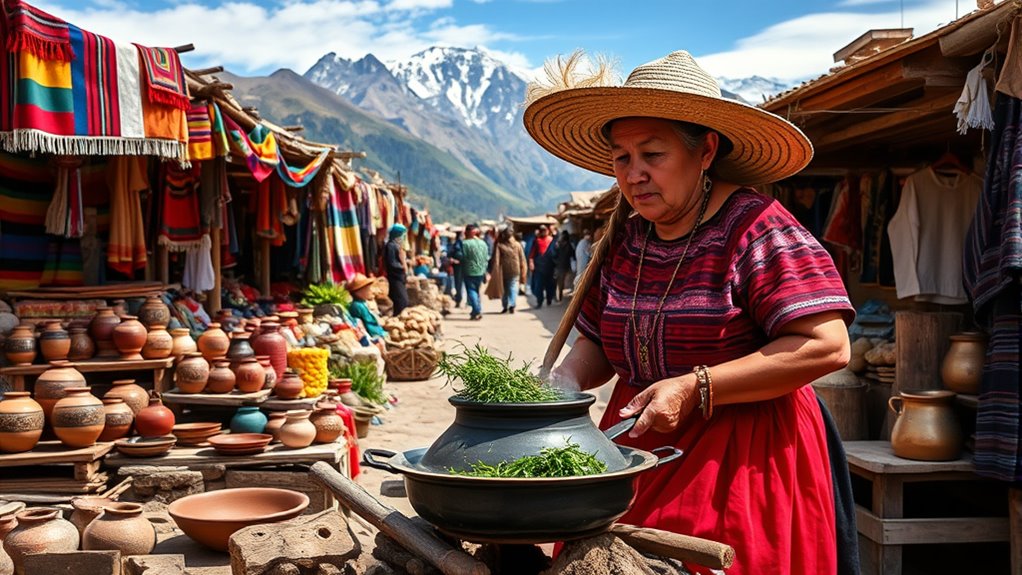
Northern Chile’s rich cultural heritage comes alive through its vibrant traditions and flavorful cuisine, offering an authentic taste of local life. As you explore, you’ll discover how the local cuisine reflects the region’s diverse landscape, featuring dishes like curanto and fresh seafood. Alongside these flavors, traditional music fills the air with lively rhythms from genres like cueca and huayno, connecting you to the area’s cultural roots. Participating in local festivals and listening to performances gives you a deeper appreciation for the community’s history and spirit. Embracing these traditions, you’ll experience the warmth and resilience of Northern Chileans, making your journey not just a visual adventure but a sensory one, rich with authentic tastes and sounds that define this unique region.
Reflecting on the Shared Heritage of Peru and Chile

You’ve already experienced the rich local traditions and flavors of Northern Chile, but this region’s cultural tapestry shares deep roots with neighboring Peru. Reflecting on this shared heritage reveals fascinating connections:
- Peruvian textile art influences many woven patterns found across the border, showcasing intricate designs passed through generations.
- Chilean folk music often incorporates rhythms and melodies similar to traditional Peruvian tunes, highlighting cultural exchanges.
- Festivals in border regions celebrate both countries’ histories, blending customs and storytelling.
- Artisans from both nations exchange techniques, preserving ancient craft traditions and fostering mutual respect.
This shared cultural landscape emphasizes how Peru and Chile’s histories intertwine, creating a vibrant, unified heritage worth exploring.
Frequently Asked Questions
What Are the Best Times of Year to Visit Peru and Chile Together?
You should visit Peru and Chile together during the shoulder seasons of spring (September to November) and fall (March to May). During these times, you experience pleasant seasonal weather, avoiding peak crowds. Plus, you can enjoy vibrant travel festivals and cultural events without overwhelming tourist rush. These months offer ideal conditions for exploring both countries’ diverse landscapes, from Machu Picchu to the Atacama Desert, making your trip more enjoyable.
How Do Local Customs Differ Between Northern Chile and Peruvian Regions?
Like a vibrant tapestry, northern Chile and Peruvian regions showcase unique customs. You’ll notice that cultural festivals in Peru are lively and rooted in indigenous traditions, while northern Chile emphasizes a blend of Andean and coastal influences. Traditional cuisines differ too: Peru’s ceviche and aji de gallina contrast with Chile’s seafood and empanadas. Embrace these differences, and you’ll truly experience the rich diversity that makes each place special.
Are There Any Safety Concerns When Traveling Between Peru and Chile?
When traveling between Peru and Chile, you should stay aware of border security and health precautions. Be prepared for possible customs checks and verify your documents are in order. Follow health guidelines, such as vaccinations or masks if required, especially during flu season or health alerts. Keep your belongings secure and stay informed about any safety advisories. Taking these steps helps ensure a safe, smooth journey across the border.
What Are the Visa Requirements for Travelers Crossing From Peru to Chile?
Think of crossing borders like opening a well-locked door—you need the right key. For your border crossing from Peru to Chile, you must meet Chile’s visa regulations, which vary depending on your nationality. Citizens of certain countries may need a visa, while others can enter visa-free for short stays. Always verify the latest requirements before your trip to guarantee smooth border crossing and avoid surprises.
How Can Travelers Support Local Communities During This Journey?
To support local communities during your journey, embrace sustainable tourism practices and seek cultural immersion opportunities. Shop at local markets, stay in family-run accommodations, and participate in community-led tours. Respect local traditions and environments, minimizing your ecological footprint. Your efforts help preserve cultural heritage and boost local economies, ensuring that future travelers can enjoy authentic experiences while communities thrive with the benefits of responsible tourism.
Conclusion
This 15-day journey is your passport to unraveling the tapestry of Peru and Chile’s shared soul. Like a vibrant mosaic, each experience—from Machu Picchu’s mystique to Atacama’s fiery geysers—connects you to a rich, intertwined heritage. Embrace the adventure, let the landscapes paint your memories, and carry home a piece of this remarkable story. Your voyage through these lands is a bridge, forever linking their timeless stories to your own.
